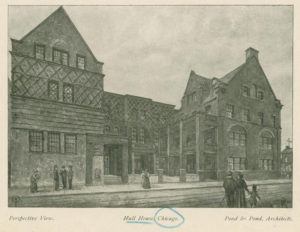Jane Addams, Immigrants, and Endless Possibilities

Jane Addams, an advocate for immigration, gave a speech on October 28, 1907 at Carnegie Music Hall in which she expressed the many talents that immigrants offer to America despite the constraints they face. Jane Addams’ concerns for immigrants were depicted in her autobiography, 20 Years at Hull-House, where she asserts that immigrants and their traditions should be respected, and immigrants should be assisted in assimilating into American culture.^1 In her inclusive speech, which can be found here, she expresses that societal advancements are often gained from those who immigrate to the United States from other countries. She also asserts that by accepting and understanding the differences between native-born Americans and new immigrants to America that there “will be a material advancement in culture and appreciation of the finer crafts.”^2 Jane Addams’ messages of inclusivity also express that immigrants have the utmost potential, especially in material achievement of the crafts. She expresses despair that immigrants are forced into types of work that are below their capabilities being that they were skilled tradesmen in their native lands. Jane Addams describes the diverse trades immigrants are skilled in, ranging from metal workers to furniture makers and other creative forms. She advocates for them entering fields and types of work where they will best thrive so they reach their utmost potential as Americans.^3 Despite my topic being centered around economic disparities between classes across periods of American history, immigration relates to the economy. Immigrants increase the supply of labor in the nation. There are misconceptions that immigration is a disservice to the American economy, but as Jane Addams supports, immigrants add value to America and its workforce. Additionally, the Hull House in Chicago was the prototype for fixing the causes and symptoms of poverty, which only helped the economy.^4 Assisting those new to the country (immigrants) and central to the country (women and children) were root purposes of the Progressive Era.
Jane Addams gave this speech in 1907. The date is significant to the context because during this time, immigration restrictions were placed on Japanese individuals who were trying to migrate to the United States.^5 The U.S. was regulating immigration and approving migrants at their discretion while it was looked down upon to accept more immigrants into the country. This was a catalyst for the sentiments set against immigrants in general, which eventually resulted in forced assimilation in some cases since America wanted immigrants for forego their own cultures and become purely and distinctly American. Jane Addams argues that immigrants add value to the nation and should be valued for their skills, not ostracized within American society. The speech also places special focus on Chicago and the hardworking immigrants residing within the city. It does reflect Jane Addams living in a hull-house in Chicago; she asserts that Chicago is full of immigrants with amazing potential in material achievements, and she supports her assertion with their work done at Hull House.^6 In 1906, Chicago’s population grew with 64,000 immigrants.^7 The Hull House being in Chicago created a “haven of refuge” for immigrants as they sought better futures and better conditions than the ones they left.^8

This speech took place at Carnegie Music Hall in Pittsburgh, Pennsylvania; it was the opening lecture of the University Extension Society.^9 This setting impacts its content because it was a venue for musical excellence, and Jane Addams giving a speech in a venue such as the music hall would only add to her purpose and audience of wealthy intellects who were in the positions of offering aid to the nation. Many strides were taken during the Progressive Era to help immigrants, women, and children, and Jane Addams’ persistence furthered the initiatives for better conditions and more promising futures for all inhabitants of the United States.
Bibliography
(^2, ^6, and ^9) Addams, Jane. “The Possibilities of the American Immigrant, October 28, 1907 (Excerpt).” Pittsburgh Daily Post, Jane Addams Digital Edition, October 28, 1907.
(^4 and Image 2) Friedman, Yael. “Carnegie’s Gift: The Progressive Era Roots of Today’s Branch Library.” Urban Omnibus, October 1, 2014.
(^3) “Give Aliens Chance.” The Pittsburgh Press (Pittsburgh, Pennsylvania), October 29, 1907. Page 8.
(^1) History.com Editors. “Jane Addams.” History.com. A&E Television Networks, April 16, 2010.
(Image 1) Michals, Debra. “Jane Addams.” National Women’s History Museum, 2017.
(^7 and ^8) “Ten Nights in a Bar-Room.” Newspapers.com. Chicago Tribune (Chicago, Illinois), January 20, 1907. Page 55.
(^5) “The New Immigration Law.” The Hawaiian Gazette (Honolulu, Hawaii), March 1, 1907. Page 6.